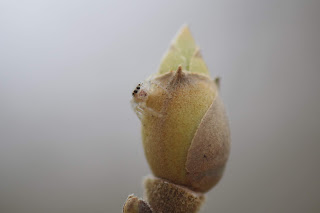This moth, for example, I never would have seen if it hadn't flown to a new spot when I got close to it:
The curious thing, though, is when an insect seems to be moving in order to be seen. I may not have seen this fly on this tree trunk if it had not been fluttering its wings:
Now, I don't know why it was fluttering its wings, but sometimes I think insects are doing that in order to attract the attention of another of their species, but one of the opposite sex.
Of course, staying still to avoid being seen doesn't just work for prey, it works for predators, too.
These assassin bugs blend in rather well among the leaves, and they sit very still there, waiting for some prey insect to land there without noticing them.
I almost didn't see this Backyard Bug of the Day:
Green Lacewing. It was on the side of this opening leaf, and in spite of the color difference, it looked like part of the plant when I first glanced at it. If was very nice to find one in nature; usually I see them on the walls of the porch, attracted by the light.
Moth
Wasp. This looks like a female ready to lay some eggs.
One fly...
... two flies...
Click beetle
Arachnid Appreciation:
.
.
.
.
.
.
.
.
.
.
.
.
Jumping spider
Jumping spider feeding on another jumping spider
















No comments:
Post a Comment